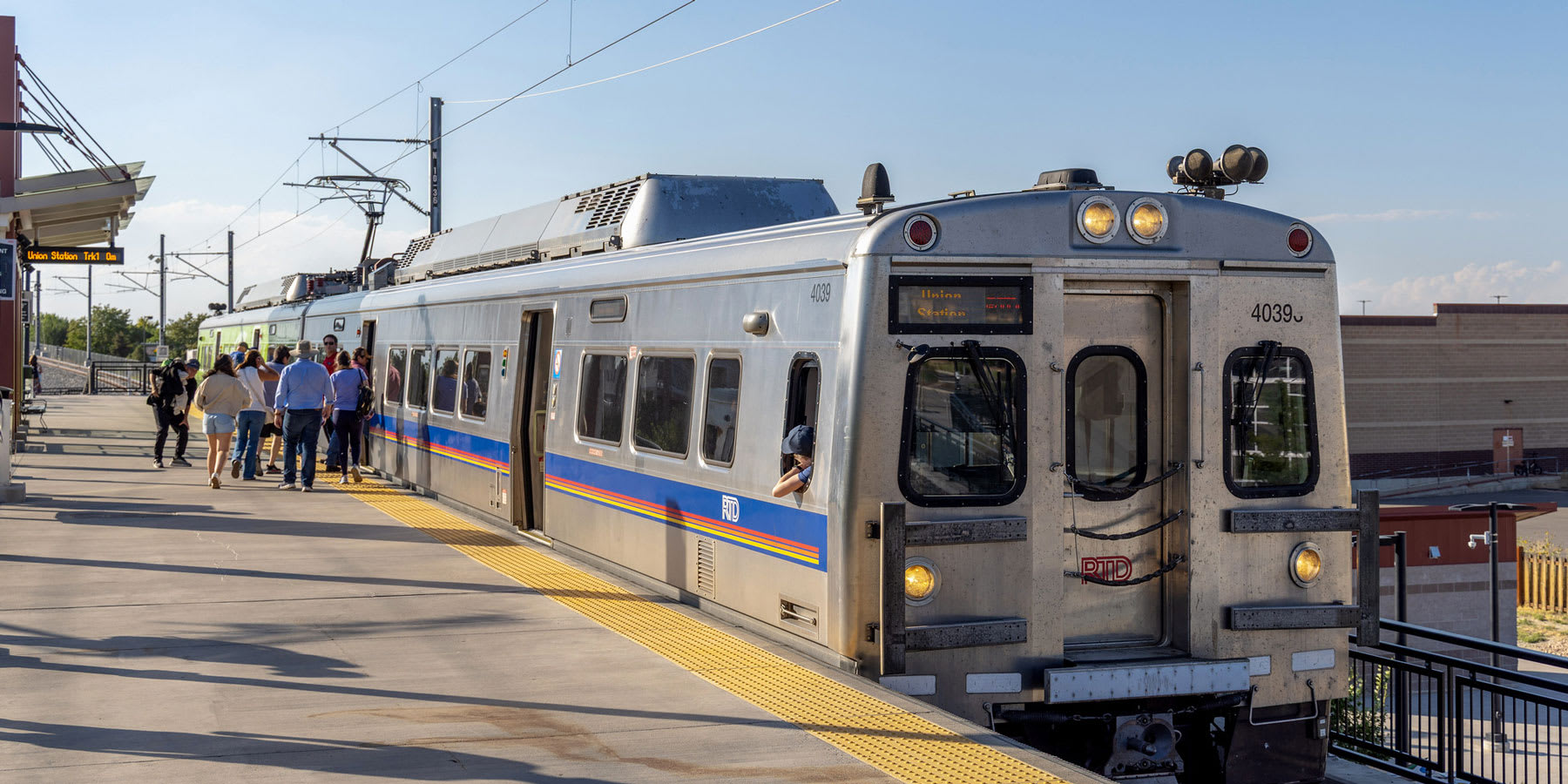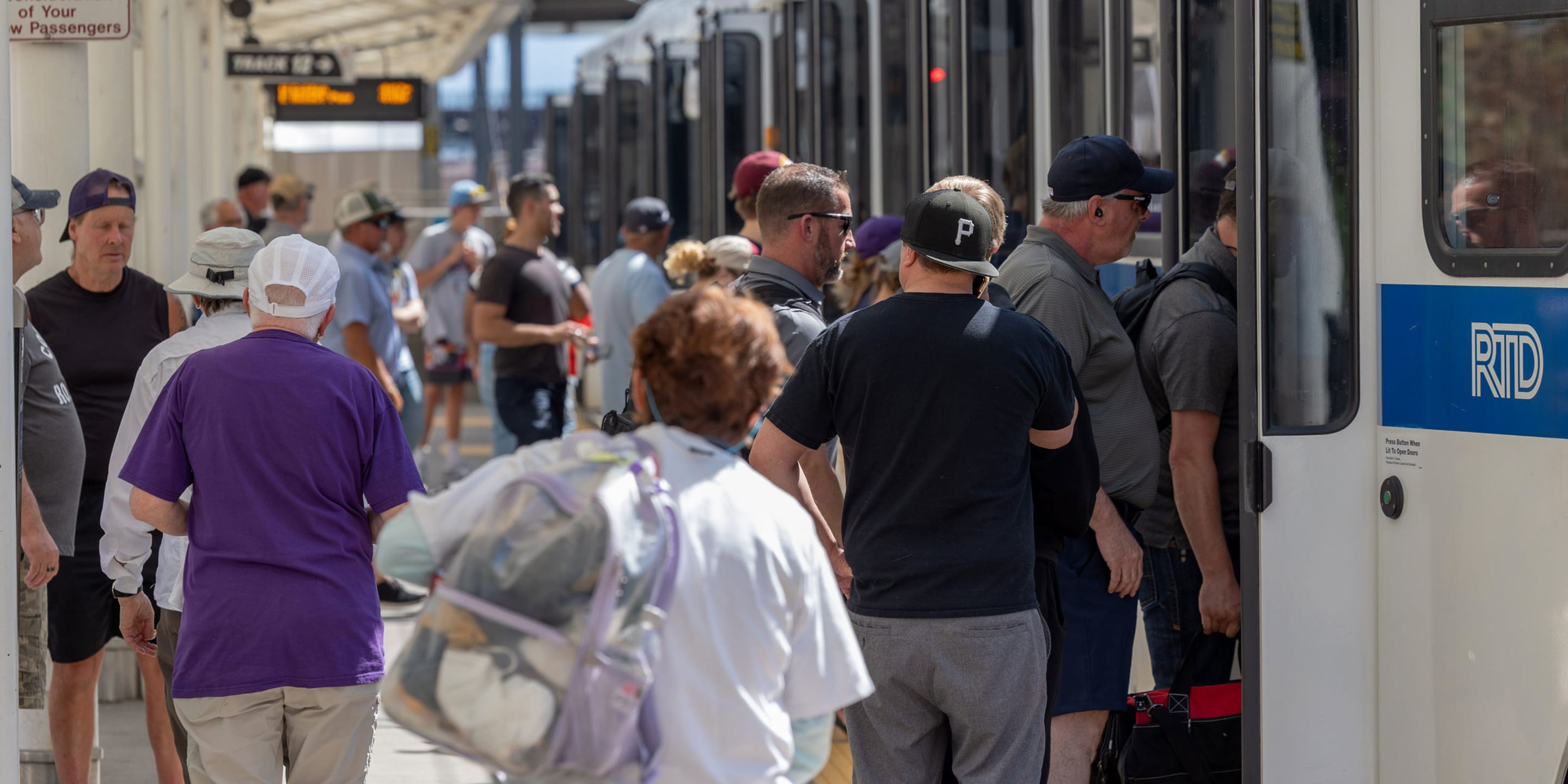
RTD doubles down on efforts to improve service and enhance the customer experience
Latest monthly ridership report reflects a 4.6% year-over-year increase in boardings as the agency prepares to roll out new customer-support resources
Sam Gallimore has been taking the N Line to his job in downtown Denver since the rail line first opened in September 2020. Gallimore, a resident of Weld County, comes into the office at least three days a week and says he never drives.
“This is the most convenient way to connect to downtown Denver and the rest of the metro area,” Gallimore said. “I don’t want to deal with traffic or pay for parking, so the N Line is a great tool. I am not only saving money, but I’m also able to make several different connections at Union Station.”
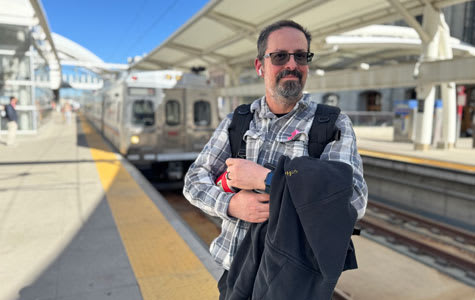
Prior to Gallimore first stepping aboard the N Line five years ago, he took an RTD bus to work every day from his home that’s approximately 30 miles north of Denver. Since the onset of the pandemic in 2020, the number of in-office days required at his downtown job has changed – now up to three each week – but his choice to use RTD’s buses and trains has remained the same.
Gallimore’s in-office requirements and remote work flexibility closely mirror the situation for tens of thousands in Colorado. As commuting patterns evolve post-pandemic, RTD is working to rebuild ridership, improve reliability, and enhance the customer experience across its entire system. The agency’s recent progress, and its plans to roll out new digital tools and customer-focused initiatives, show how RTD is adapting to meet the needs of its customers – both now and in the future.
Commuting trends and return-to-office requirements
Return-to-office numbers in the Denver metro area, which accounted for a significant percentage of RTD’s ridership prior to March 2020, remain below pre-pandemic levels. According to the Downtown Denver Partnership (DDP)’s September 2025 High Frequency Economic Update, the weekday return-to-office rate was 64%, a number that is seven percentage points higher than the previous year. DDP’s report highlights the fact that, while the number has been gradually increasing over the past few years, approximately 35,000 fewer employees are working downtown each weekday when compared with 2019.
Other parts of the metro area are seeing similar return-to-office rates. Denver South, an organization of community and business leaders along the I-25 corridor that includes the Denver Tech Center, conducts an annual survey to better understand commuting trends and behaviors. Their most recent commuter survey found that 35% of respondents work full-time at a workspace in Denver South, with the remaining approximately two-thirds have a mix of in-office and remote days. That same survey also found that 33% of respondents’ employers either fully or partially subsidize an RTD transit pass for their workforce.
“Transit service delivery is RTD’s core business, and due to a myriad of factors, that service delivery model has had to adjust,” said Debra A. Johnson, RTD General Manager and CEO. “Large numbers of commuters boarding buses and trains during morning and evening peak service times are not at the levels previously seen by the agency. Instead, RTD is seeing transit utilization spread more throughout the day, late in the evening, and on weekends.”
Transit utilization trends and ridership increases
Between January and August of this year, RTD had more than 42 million boardings across its entire system. The agency uses boardings – often referred to as ridership – as one of many metrics to gauge the agency’s success. Ridership is an output metric that is the result of multiple factors, including on-time performance, service availability, perceptions of personal safety and security, and planned and unplanned maintenance projects. RTD also recognizes that ridership is greatly impacted by economic conditions, seasonal demands, remote work trends, and other external events happening across the agency’s 2,345-square-mile service area.
“Transit utilization is the result of several different efforts, and it requires a laser-like focus on enhancing and improving the customer experience. RTD’s staff has been doubling down on efforts that are within the agency’s control that will create and bolster a welcoming transit environment,” Johnson said.
In August 2025, systemwide ridership was 5.6 million, an increase of 4.6% from August 2024. August’s numbers, which are the most recent numbers available, also saw nearly 475,000 more boardings than the previous month.
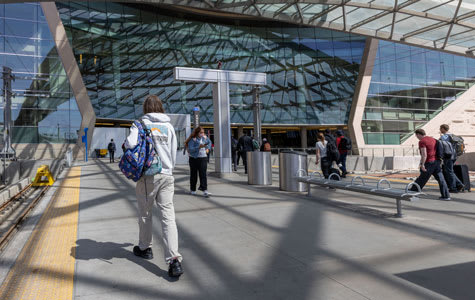
This year, RTD has also been heavily promoting its A Line, the commuter rail line that connects downtown Denver to Denver International Airport, and those marketing efforts appear to be paying off. At approximately 650,000 boardings in August 2025, the A Line saw its second highest monthly ridership during the past five years. August's total number of boardings was within 5,000 of the A Line’s record monthly total from August 2023, when the state funded the Zero Fare for Better Air initiative that allowed all customers to use RTD’s services at no cost.
In August 2025, the N Line experienced its highest number of monthly boardings since the north metro line first opened for service in September 2020. Ridership on the E and H lines more than doubled over the previous August, a fact that RTD says is the result of the completion of months of maintenance work that necessitated temporary speed restrictions. Bus boardings also increased by approximately 230,000 month-over-month between July and August 2025, accounting for a total of nearly 3.6 million in the report.
These gains in ridership across the system and different modes mirror customer survey data gathered earlier this year that indicated “using public transit to get to work” was the No. 1 reason people took RTD. The survey of customers aboard buses and trains saw a 7% year-over-year increase in customers indicating that work was their reason.
High-volume events and activity centers
The same customer survey found that approximately one-third of respondents use RTD’s services for “leisure, social, or recreation.” Using that feedback, RTD is broadening its focus beyond traditional commuter services that support in-office schedules to also include access to transit-adjacent event venues and activity centers. The agency is enhancing its base bus and rail services to strengthen connections to major sporting venues, concerts, festivals, parades, and other high-volume events happening across the Denver metro area.
Vern Webber, who regularly rides the 0, 6, and 10 bus routes with his wife to the symphony and Rockies games, said he takes transit to “avoid the exorbitant parking fees and hassles of finding parking spaces.” He noted that bus operators are friendly and helpful, and RTD’s buses are his preference for reaching downtown event venues.
The agency closely monitors several metro area calendars to flag events taking place near bus stops and rail stations that have a potential to generate high transit use. RTD also coordinates its efforts with Visit Denver to discuss upcoming conferences and large-scale events. The information and schedules provide valuable insights for developing operational plans and determining staffing levels to support transit utilization. The agency’s focus is to optimize its existing bus and rail services to support peaks in demand without disrupting base service across its entire system.
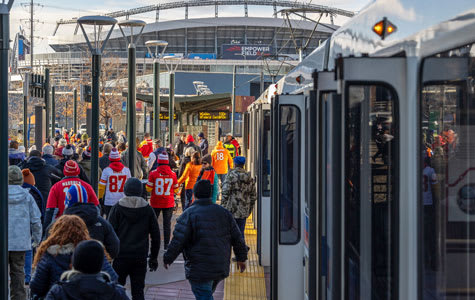
During the 2024-2025 Denver Broncos season, RTD saw nearly 27,000 light rail boardings at the stadium’s platform before and after every home game. The agency recorded nearly 38,000 boardings during the Broncos vs. Raiders home game in October 2024. RTD says the 2025-2026 NFL season is seeing a similar trend in customers taking buses and trains to access Broncos home games.
In November, RTD will launch a high-volume events website to provide updates, information, and feedback opportunities. The online resource will include several different service maps showing all bus routes and rail lines that connect to transit-adjacent venues. The website will also provide trip planning and know-before-you-go information, as well as event calendars for the Denver metro area. In launching the website, the agency is hoping customers, event organizers, and the public will use the online feedback tool to share feedback and suggestions for improving event service.
Pass programs support ridership increases
Despite a universal shift in working environments, RTD’s 35-year-old EcoPass program, which offers unlimited rides on RTD’s fixed-route bus and rail services, is seeing participation approach 75% of pre-pandemic level. Nearly 600 metro area employers, ranging in size from small, home-based businesses to large companies with thousands of employees, are currently offering the transit pass as a perk. The prepaid EcoPass allows customers whose employers participate in the program to use the pass when traveling anywhere throughout the agency’s service district.
The Neighborhood EcoPass program, RTD’s transit pass for residents in a neighborhood or community, is seeing its highest participation since the program’s launch in 1991. The program currently has more than 70 neighborhoods participating, which is the highest number in RTD’s history. Seven higher education institutions also participate in RTD’s CollegePass program, including the University of Colorado, University of Denver, and Colorado School of Mines. Several other metro area colleges and universities take advantage of a similar, opt-in SemesterPass program, including Regis University and institutions at the Auraria Campus.
Service reliability and on-time performance
Reliability remains a cornerstone of RTD’s Strategic Plan, which focuses the agency’s efforts on supporting reliable transit services, reinforcing personal safety, and enhancing the customer experience. Several tactics outlined in the 2025-2026 annual agency performance scorecard directly support the delivery of service and emphasize improvements to on-time performance, trips operated, and service perceptions.
On-time performance is a measurement of how frequently buses and trains arrive at stop or stations according to the posted schedule, with “on-time” being defined as a vehicle arriving no more than one minute early or five minutes late. On-time performance can be affected by several factors, including maintenance work, inclement weather, mechanical issues, accidents, customer boarding times, and traffic conditions that impact bus service.
RTD’s on-time performance for light rail service exceeded 90% in July 2025, as compared with less than 60% in August 2024, and that number has continued to incrementally improve. Additionally, 97.9% of all light rail trips were operated as scheduled that month. Completing both the Coping Panels Project and the first phase of the Downtown Rail Reconstruction Project, along with expedited operator hiring, positively affected service reliability for light rail customers.
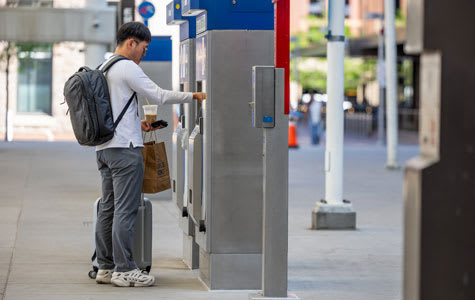
On-time performance for commuter rail, which includes the A Line to the airport, has averaged more than 96% throughout 2025, with more than 98% of all trips operated as scheduled. On-time performance for bus remained above 83% between January and July 2025, a metric that is heavily impacted by traffic congestion, road construction, and lack of traffic signal prioritization for all buses.
“Service reliability is addressed in every decision staff proposes and implements,” said Senior Manager of Service Development Jessie Carter. “The team continually assesses input from customers, operators, and performance reports to ensure routes are refined and schedules are improved, all with a goal of enhancing on-time performance. The team is keenly aware that customers rely on RTD to make important connections in their daily lives, so continual improvement and refinement is critically important.”
To support on-time performance, such as during this year’s Downtown Rail Reconstruction Project, RTD’s service planning team preemptively analyzed various scenarios for delivering light rail services ahead of the Aug. 31 service changes. The goal was to deliver on-time performance and minimize customer wait times at rail platforms. Rerouting the D Line to Denver Union Station was determined to provide the most reliable on-time service for customers of the several different scenarios that were evaluated.
The agency is currently collecting customer feedback through Oct. 30 ahead of its proposed January 2026 service changes. If approved by RTD’s Board of Directors, the proposed changes will further improve the agency’s service reliability.
Personal safety and security improvements
Over the past 18 months, several coordinated efforts have also been implemented to enhance the personal safety and security of RTD’s employees and customers. The multi-faceted approach to create a welcoming transit environment, which has been led by RTD’s Transit Police Department (RTD-PD), has resulted in an approximately 25% monthly reduction in security-related calls throughout 2025. This includes everything from customer-reported concerns to RTD-PD officer observations. For more than 14 consecutive months, the agency has also seen double-digit reductions in customer reports of illicit drug activity across the system, with last month experiencing a nearly 30% year-over-year decrease in total reports.
“Whether a customer is waiting for a connection or traveling on a bus or train, we are focused on providing a welcoming transit environment,” said Steve Martingano, RTD’s Chief of Police and Emergency Management. “The personal safety and security of all customers and agency employees is supported by a comprehensive and coordinated effort. We know that a lot of misperceptions exist in the metro area related to personal safety and security. While we recognize that there are opportunities for improvement, the overwhelming majority of customers complete their trips without any issues or concerns.”
In August 2025, RTD received one security-related call for service for every 2,069 boardings. Calls for service can include everything from reports of an unattended bag and graffiti to a fight or theft. Earlier this year, the agency launched a security-related metrics webpage to provide a transparent look at the agency’s data related to personal safety and security, including all calls that are reported by Transit Police officers, operators, customers, and the public.
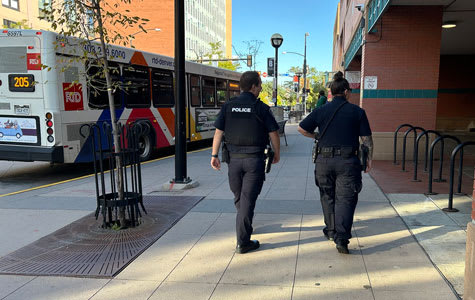
Natasha Mitchell doesn’t own a car, uses RTD, and has personally seen the improvements in safety. “I have noticed the step up in security,” she said. “Problem areas where drug users were previously gathering seem to have been swept clean and (RTD officers) have been able to maintain that.”
Mitchell’s observations mirror survey results from earlier this year that point to an 11% year-over-year increase in bus customers feeling safe and secure and a 12% increase for rail customers.
Since May 2024, RTD has also increased monthly proof-of-payment checks on light rail vehicles by more than 900%, from approximately 5,700 individual checks to 60,000 last month alone. Across the entire rail system, RTD conducted more than 460,000 proof-of-payment checks in September 2025. The effort puts RTD-PD officers and contracted security personnel directly in contact with customers and increases their visibility to address other issues that may be present.
Near-term customer experience tactics
Simplifying the transit experience and reducing barriers for customers are top priorities for RTD. Next month, the agency will introduce a long-awaited tap-to-pay program branded as Tap-n-Ride. The easy-to-use payment method will allow customers to tap a contactless credit or debit card — either a physical card or in a mobile wallet — on bus and rail validators. The new fare payment option will allow customers to quickly and efficiently purchase fare without the need to use a ticket vending machine, pay cash on the vehicle, download the agency’s mobile application, or load value on a MyRide card. Work to introduce Tap-n-Ride has been underway for more than a year.
Also next month, RTD will begin implementing a multi-faceted customer experience action plan. The plan includes more than 50 projects and tactics that focus on enhancing customer amenities, improving communications, increasing awareness, and bolstering engagement and feedback. All tactics included in the plan have a near-term deadline of June 2026 and were developed to increase transit utilization. RTD will make the plan publicly available when it launches in November.
In mid-2026, RTD will also roll out a single mobile application that combines existing applications, such as Next Ride, MyRide, and Transit Watch, into one single customer-facing app. The new app, which will be branded as Next Ride, will be available for download in app stores and will simplify trip planning, fare purchasing, and the reporting of personal safety and security concerns.
Next steps
Resilience is the ability to recover from or adjust to challenges and change. Over its 56-year history, RTD has demonstrated resilience by expanding its system during economic downturns, maintaining service during the pandemic, and rebuilding aging infrastructure. Now, as commuting patterns change course and new technologies emerge, the agency is once again adapting. Through strategic investments in service reliability, maintenance work, safety initiatives, and customer experience, RTD remains focused on its mission to make lives better through connections.
